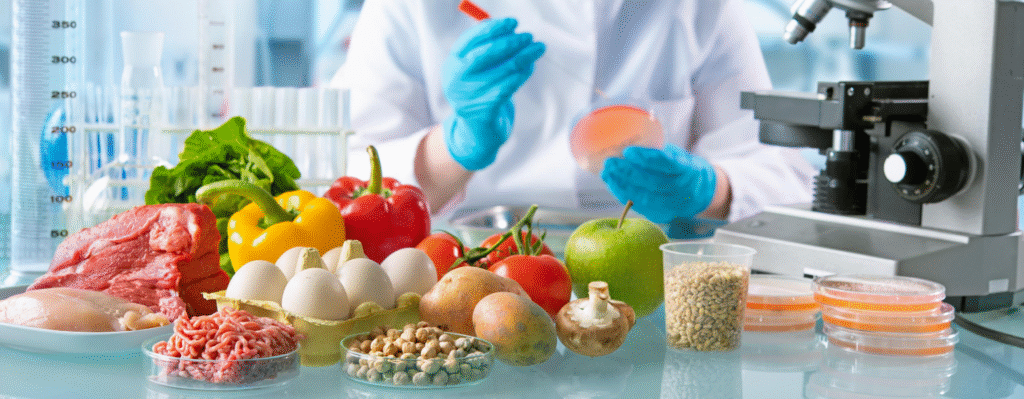What Is Food Biotechnology?
Food biotechnology is the science of improving plants, animals, and microorganisms used for food production through genetic engineering and other modern technologies. Instead of relying solely on traditional farming methods, scientists now use tools like DNA editing to create crops that are more resistant to pests, grow faster, last longer, and even offer better nutrition.
Think of it as combining biology with innovation — not to create unnatural food, but to solve real-world challenges in food security, sustainability, and nutrition.
Why Food Biotechnology Matters Today
We live in a world facing multiple food-related challenges:
- A rapidly growing global population
- Climate change affecting crop yield
- Increasing demand for nutritious, safe food
- Limited natural resources
Food biotechnology offers promising solutions. By modifying crops at the genetic level, we can improve harvests, reduce food waste, and even fight malnutrition.
🔬 How Does Food Biotechnology Work?
1. Genetic Modification (GM)
Scientists identify useful traits (like drought resistance) from one organism and insert those genes into another. For example, corn can be genetically modified to resist pests without needing chemical pesticides.
2. Genome Editing (CRISPR)
CRISPR is a newer technology that allows precise changes to the DNA of a plant or animal without inserting foreign genes. It’s like editing a typo in a document — clean and efficient.
3. Fermentation and Microbial Engineering
Biotech also includes using microbes to produce enzymes, vitamins, and even meat substitutes — like plant-based burgers or lab-grown dairy.
✅ Benefits of Food Biotechnology
1. Higher Crop Yields
Biotech crops are more resistant to diseases, pests, and environmental stresses. This means more food from the same land — a big plus for farmers.
2. Better Nutrition
Golden Rice is a famous example — it was engineered to contain vitamin A, helping fight deficiency in parts of Asia and Africa.
3. Less Chemical Use
Crops that resist pests or weeds reduce the need for chemical pesticides and herbicides, which is better for human health and the environment.
4. Longer Shelf Life
Biotech can help fruits and vegetables stay fresh longer, reducing food waste and saving consumers money.
5. Sustainability
Biotech crops often require less water, less fertilizer, and grow faster — making farming more eco-friendly.
⚠️ Are There Risks or Concerns?
While food biotechnology has many benefits, it’s not without controversy.
1. Health Concerns
Some people worry that genetically modified foods (GMOs) could have unknown health effects. However, decades of research show that approved GMOs are safe to eat.
2. Environmental Impact
There are concerns that biotech crops may affect biodiversity or lead to “superweeds” resistant to herbicides. That’s why strict regulations and field testing are in place.
3. Ethical and Cultural Issues
For some communities, the idea of altering nature raises religious or ethical concerns. Transparency and informed choice are essential here.
4. Corporate Control
A handful of companies dominate the biotech seed market, raising worries about farmer dependence and seed pricing.
🌍 Real-World Examples of Food Biotechnology
- Bt Cotton and Corn: Engineered to produce proteins toxic to specific pests but safe for humans. Widely used across the U.S., India, and Brazil.
- Impossible Burger: Uses genetically engineered yeast to create heme, the molecule that makes meat taste like meat.
- Arctic Apples: These apples don’t brown when sliced, making them more appealing and reducing waste.
🏛️ Regulation and Safety: Who Oversees Biotech Foods?
Food biotechnology is heavily regulated. In the U.S., for example:
- FDA checks safety and nutritional content.
- USDA reviews environmental impact and farming regulations.
- EPA assesses pesticide-producing crops.
Globally, bodies like the World Health Organization (WHO) and FAO also set safety guidelines.
Every genetically modified food goes through years of safety testing before approval.
🔮 What’s the Future of Food Biotechnology?
The future is exciting. Researchers are working on:
- Climate-resilient crops that survive floods or extreme heat
- Edible vaccines in bananas or tomatoes
- Meat grown directly from animal cells (cultured meat)
- Crops that naturally fertilize themselves, reducing the need for chemicals
Food biotechnology may soon help address world hunger, reduce emissions, and bring personalized nutrition to your dinner plate.
🧠 Final Thoughts: Should You Be Concerned?
Food biotechnology isn’t science fiction — it’s already in your grocery store. From sweet corn to soybeans, many of the foods we eat today are biotech-enhanced. And that’s not a bad thing.
As with all innovations, balance and transparency are key. With continued research, regulation, and public dialogue, food biotechnology can help us build a food system that is safer, more sustainable, and truly built for the future.
🔍 Key Takeaways
- Food biotechnology uses science to improve the quality, yield, and safety of food.
- It offers solutions for global issues like hunger, climate change, and nutrition.
- Genetically modified foods are extensively tested and generally recognized as safe.
- Ethical, environmental, and social considerations must remain part of the conversation.

